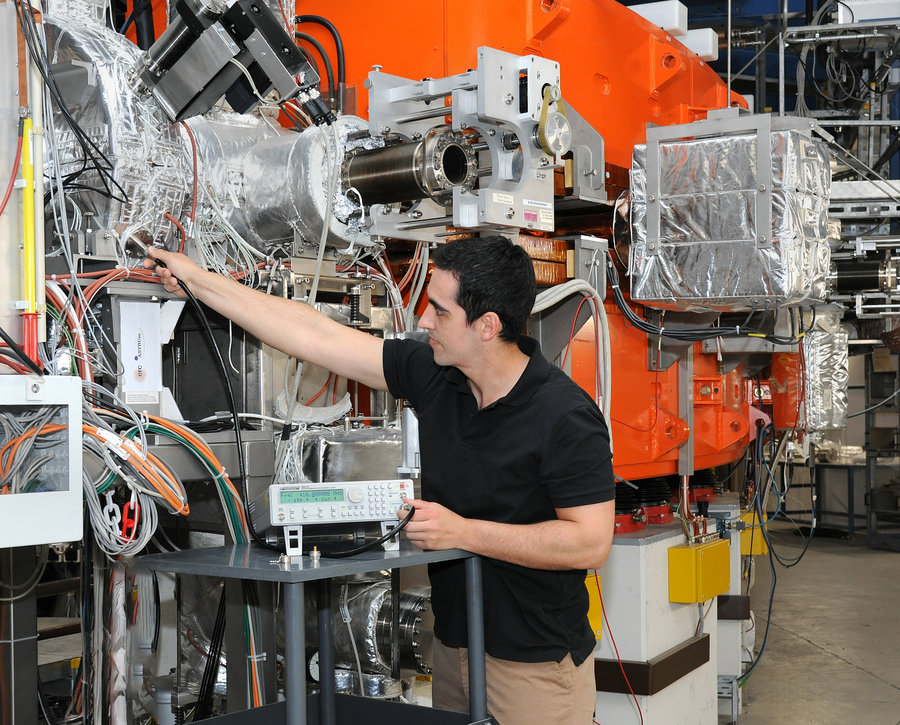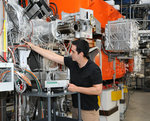Unexpected deviation in the lifetime — First observation of the nuclear two-photon decay in bare atomic nuclei
17.07.2024 |
Joint press release by GSI/FAIR and Max Planck Institute for Nuclear Physics
For the first time, an international research team, led by GSI/FAIR in Darmstadt, the Institut de recherche sur les lois fondamentales de l'Univers (IRFU) in Saclay, France, and the Max Planck Institute for Nuclear Physics in Heidelberg (MPIK) has succeeded in observing a two-photon decay on a so-called bare atomic nucleus from which the entire electron shell has been removed. The measurements on germanium-72 nuclei were carried out as part of the FAIR Phase 0 experimental program at the experimental storage ring ESR at GSI/FAIR. The results have been published in the journal Physical Review Letters.
Nuclear two-photon or double-gamma nuclear decay is an electromagnetic process in which a nucleus in an excited state emits two gamma rays simultaneously. This new type of decay was first discovered in the 1980s at the MPIK, but further investigations were hardly possible due to its rare nature. Studying this process gives insight into fundamental properties of the nucleus, such as the reaction to electromagnetic fields in different states of excitation.
In the recent experiments, this rare phenomenon was studied in a specific isotope of Germanium, with mass number A=72, which was stripped of its entire electron shell. For this purpose, a beam of krypton ions was accelerated to about 70% of the speed of light with the GSI/FAIR accelerator facility and subsequently passed through a beryllium plate with a thickness of one centimeter. In the collision, the required germanium ions are produced in a specific excited state, which has the same spin-parity quantum number 0+ as the ground state.
“In this situation the usually dominating decay by the emission of a single gamma-ray is forbidden due to angular momentum conservation, since the gamma ray must take away an intrinsic spin of one unit,” says the project leader, Dr. habil. Wolfram Korten, scientist at IRFU. “Other competing decay modes, such as the transfer of the energy to an electron of the atomic shell, are also not possible, because we intentionally removed all electrons. Therefore, the double-gamma decay becomes the dominant decay mode.” The scientists utilized this situation to directly measure the partial half-life for the double-gamma emission.
“In a nuclear reaction at relativistic energies the produced ions inevitably have a large velocity spread,” explains Professor Yury Litvinov, who was responsible for the conduction of the experiment at GSI/FAIR. “To force the same ion species to have identical revolution frequencies, we tuned the experimental storage ring ESR at GSI/FAIR into a special ‘isochronous’ mode, such that the differences in velocities are exactly compensated by the lengths of ion trajectories. As a result, we were able to reliably separate the ground and the isomeric states of germanium-72 ions despite their very slight relative mass difference of the order of 10-6. ”
“We tracked each ion in the isomeric state non-destructively and precisely determined the time of its decay. Thus, the half-life for the double-gamma decay of the first excited 0+ state in bare germanium-72 ions was determined to be 23.9(6) milliseconds, which is fifty thousand times longer than in the atomic state and strongly deviates from theoretical expectations,” adds Dr. David Freire Fernández, first author and PhD student at the MPIK at the time of the measurement. “The measured half-life is by at least two orders of magnitude shorter than the shortest lifetime directly measured previously for stored highly-charged ions.”
“The obtained short lifetime was not expected and we are extremely intrigued to find the theoretical explanation for this. Further experiments will be required to harmonize theory and experiment for this rare phenomenon,” concludes Professor Klaus Blaum, Director of the MPIK in Heidelberg. (CP)















